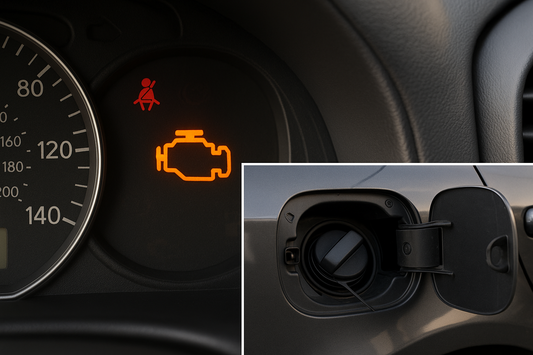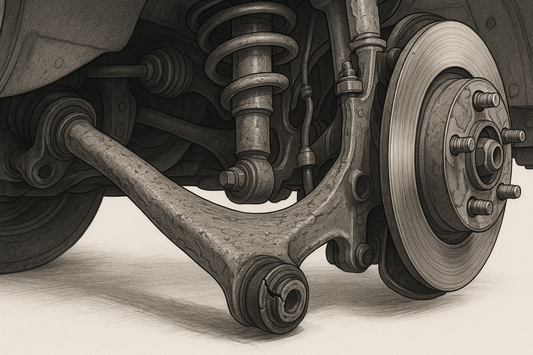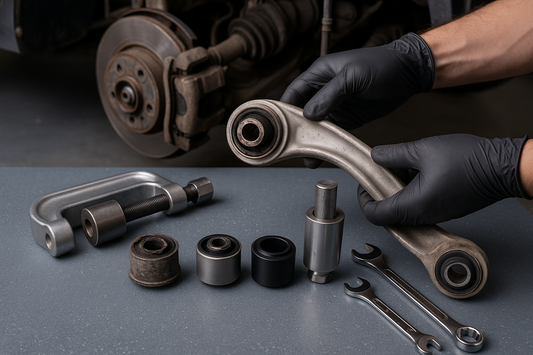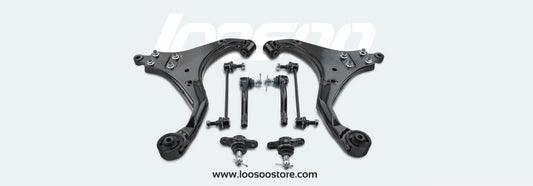If you’ve ever wondered why your car steers smoothly—or why it might start pulling to one side—you’re probably dealing with tie rod ends. These small but critical parts are the unsung heroes of your vehicle’s steering system, connecting the steering wheel to the wheels themselves. In this guide, we’ll break down what tie rod ends are, how they work, common signs of wear, and how to pick the right ones for your car—with a focus on quality, safety, and trusted brands like Loosoo.
What Exactly Are Tie Rod Ends?
Tie rod ends are key components of your car’s steering system, acting as the link between the steering linkage and the wheels. Think of them as the “translators” that turn your steering wheel’s rotation into the side-to-side movement that directs your car’s path.
Most tie rod ends use a ball-and-socket design, which allows for flexibility while keeping the connection strong. This joint pivots as you turn the wheel, ensuring smooth, responsive steering—whether you’re making a tight U-turn or cruising down the highway.
Inner vs. Outer Tie Rod Ends: What’s the Difference?
Tie rod ends come in two main types, each with a unique role in your steering system:
1. Inner Tie Rod Ends (Rack Ends)
- Location: Hidden inside the steering rack assembly, closer to the center of the car.
- Function: These connect directly to the steering rack, which converts your steering wheel’s rotation into linear motion. They transmit the driver’s input to the outer tie rod ends.
- Protection: Covered by rubber boots to keep dirt, moisture, and debris out—critical for preventing wear.
2. Outer Tie Rod Ends
- Location: Visible near the wheels, attached to the steering knuckle (the part that holds the wheel).
- Function: Link the inner tie rod ends to the wheels, affecting wheel alignment and steering control.
- Exposure: More exposed to road debris, potholes, and weather, making them prone to faster wear.
Key Takeaway: Inner tie rod ends “send” the steering signal, while outer ones “deliver” it to the wheels. Both are essential for safe, precise steering.

What Do Tie Rod Ends Do? More Than Just Steer
Tie rod ends aren’t just about turning—they’re vital for safety, alignment, and tire health:
1. Steering Control
They translate your steering wheel’s movement into wheel direction, ensuring your car goes where you want it to. A worn tie rod end can make steering feel loose or unresponsive.
2. Wheel Alignment
Properly functioning tie rod ends keep your wheels aligned (parallel and perpendicular to the road). Misaligned wheels wear tires unevenly, cost more to replace, and reduce fuel efficiency.
3. Stability & Safety
They work with your suspension to absorb bumps, keeping the car stable. A failed tie rod end could lead to sudden loss of steering control—especially dangerous at high speeds.
Signs of a Bad Tie Rod End: Don’t Ignore These Red Flags
Like any part, tie rod ends wear out over time. Here’s how to spot trouble:
Steering Issues
- Uneven Tire Wear: If your front tires are worn on the inner or outer edges, misalignment from a bad tie rod end is likely the culprit.
- Loose or Wandering Steering: The wheel feels “floppy,” and the car drifts to one side even on straight roads.
- Vibration or Shaking: A shaky steering wheel at low or high speeds often points to worn tie rod ends.
Noises & Physical Signs
- Clunking or Knocking: Hear a “clunk” when turning? That’s loose play in the ball joint.
- Off-Center Steering Wheel: The wheel isn’t straight when driving straight—another sign of misalignment.
- Difficulty Turning: The car resists steering inputs, especially at low speeds (e.g., parking).
Pro Tip: If you notice any of these, get your tie rod ends checked ASAP. Ignoring them could lead to a blown tire, lost steering, or even an accident.
How to Buy Quality Tie Rod Ends: Tips for Smart Shoppers
Replacing tie rod ends is a common repair, but choosing the right ones matters. Here’s what to look for:
1. Know Your Car’s Specs
Tie rod ends vary by make, model, and year. Check your owner’s manual or use an online fitment tool to confirm compatibility.
2. Prioritize Material & Construction
- Forged Steel or High-Strength Alloys: These withstand the constant stress of steering and road impacts. Avoid cheap, lightweight materials—they wear out faster.
- Grease Fittings: Look for tie rod ends with built-in grease nipples. Regular lubrication reduces friction and extends lifespan.
- Durable Seals: Rubber or polyurethane boots keep dirt out. Loosoo’s tie rod ends, for example, use triple-sealed boots to protect the ball joint from debris.
3. OEM vs. Aftermarket
- OEM (Original Equipment Manufacturer): Made by your car’s original parts supplier—guaranteed fit but often pricier.
- Aftermarket: Brands like Loosoo offer high-quality alternatives, often with better warranties and innovative designs (e.g., corrosion-resistant coatings).
4. Warranty & Reputation
- A good warranty (e.g., Loosoo’s 3-year limited warranty) shows the brand stands behind its product.
- Read reviews: Look for feedback on durability, fit, and customer service.

Why Choose Loosoo Tie Rod Ends?
At Loosoo, we design tie rod ends to outlast the competition. Here’s what makes us stand out:
- Premium Materials: Our tie rod ends are forged from high-strength steel, tested to handle 2x the stress of standard parts.
- Advanced Sealing: Triple-layer rubber boots keep out mud, salt, and water—critical for cars in rainy or snowy climates.
- Grease-Friendly Design: Built-in grease fittings make maintenance easy, so your tie rod ends stay smooth for years.
- Perfect Fit: Engineered to match OEM specs, ensuring hassle-free installation and precise alignment.
Final Thoughts: Keep Your Steering Safe with Quality Tie Rod Ends
Tie rod ends might be small, but they’re critical to your car’s safety and performance. By understanding their role, spotting wear early, and choosing quality replacements (like Loosoo’s), you’ll keep your steering smooth, your tires even, and your drives worry-free.










